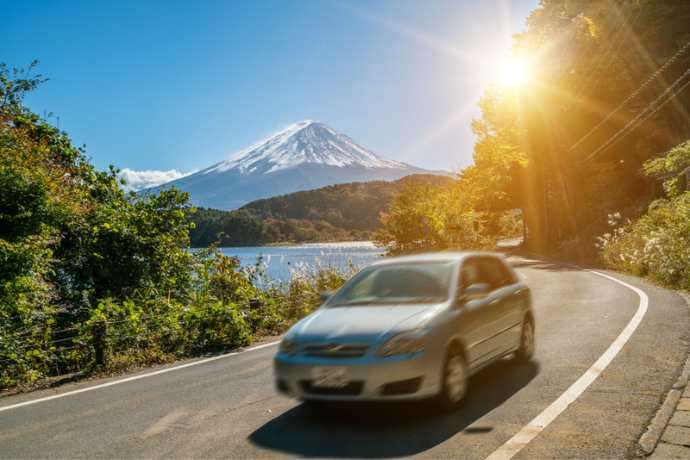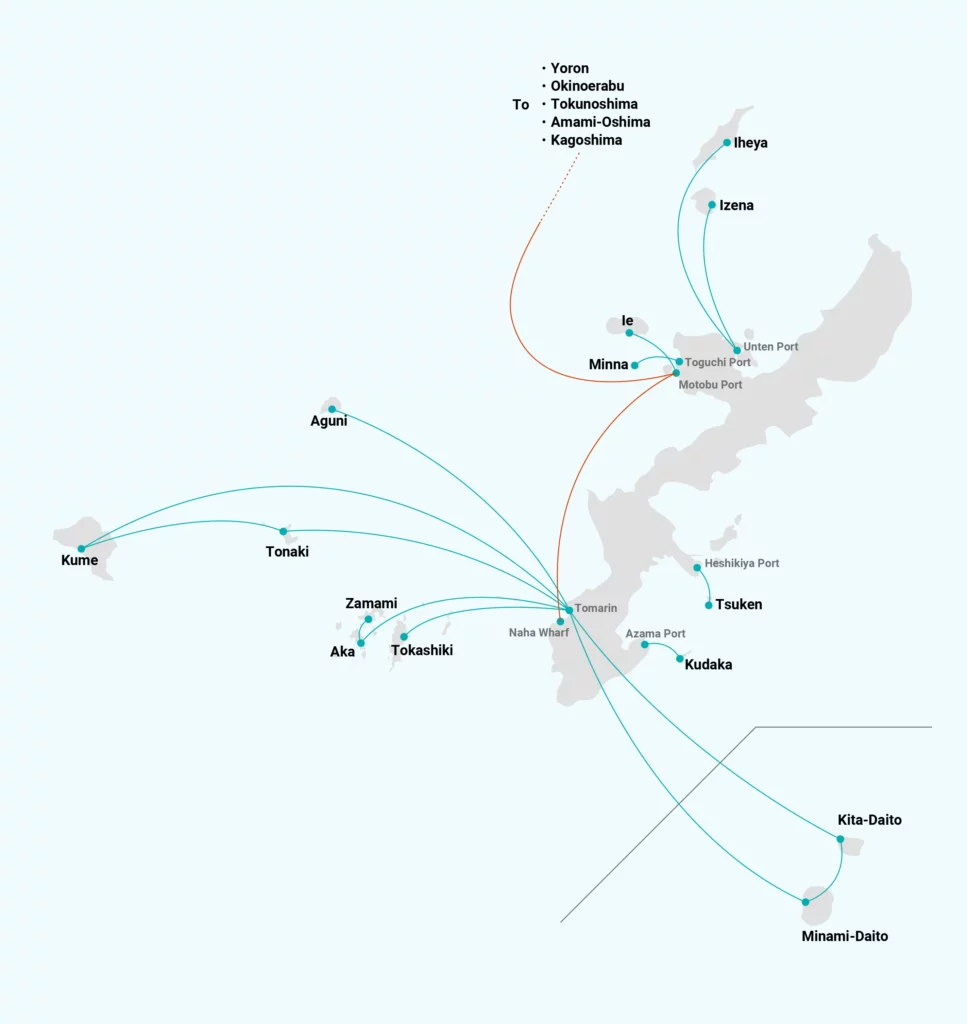Are you considering driving in Okinawa? Driving in Okinawa is much like driving in the rest of Japan, but it is more relaxed and straightforward. The weather is also fantastic (apart from the occasional typhoon).
I have driven in Okinawa more than ten times, from one end of Okinawa to the other. As long as you stay out of the typhoons, you will have a smooth ride through the tourist paradise of Okinawa.
This comprehensive guide will navigate the crucial driving aspects of this island paradise. It first weighs up whether driving in Okinawa is worthwhile and explores other transport options. The article then looks at renting a car in Okinawa, familiarises you with local driving rules, and interprets essential road signs. Towards the end, the article shares insights on parking and gas stations, and spotlights a few scenic routes, including unforgettable sunset drives. For those lingering questions? There’s a dedicated FAQ section just for that.
Buckle up, and let’s explore Okinawa on four wheels.
Disclaimer: This article contains affiliate links. If you book after clicking on one of these links then we may receive a small commission at no extra cost to you.
- Easy comparison of multiple car rental provider options using Klook, DiscoverCars or RentalCars
- TooCoo! is a local Japanese car comparison site that has the most options available
- Clear description of included protection and excess
- Good cancellation options
- Child seats, GPS, electronic toll cards, second driver and more are available as add-ons
Does it Make Sense to Drive in Okinawa?
If you want to get out of Naha city and see the sights, driving yourself is the best way to get around Okinawa island.
Driving in Okinawa offers a lot of benefits:
- It provides the flexibility to travel wherever and whenever you want without the constraints of a tour schedule.
- Cars give you access to areas that public transport may not cover and can be more time-efficient than buses, especially in rural zones.
- Cars are spacious enough for bulky items.
- Car rentals can also be more cost-effective for groups of five or more.
- Driving allows for a personalised experience of Okinawa’s scenic beauty (which many people describe as being like Hawaii).
However, there are a few downsides. Renting requires time investment in route planning, and for smaller groups, the cumulative costs of rentals, gas, tolls, and parking can become substantial.
Other Transport Options in Okinawa
Apart from renting, Okinawa offers various other transport options:
- A private driver, while more expensive, can provide a guided experience tailored to one’s interests.
- Tour buses are a more economical choice but come at the expense of flexibility.
- Taxis provide door-to-door service. However, they can be expensive over longer distances and language barriers might exist. Several companies offer a sightseeing taxi service.
- Airport transfers are ideal for those travelling directly to specific locations.
- Buses are a popular and affordable mode of transport on the main island, albeit less frequent in rural areas.
- The monorail is a convenient option in Naha but can be crowded during peak times.
- Lastly, for short-distance exploration, bike rentals are available. However, for most people, they are only suitable for short journeys and aren’t much fun in unfavourable weather conditions.
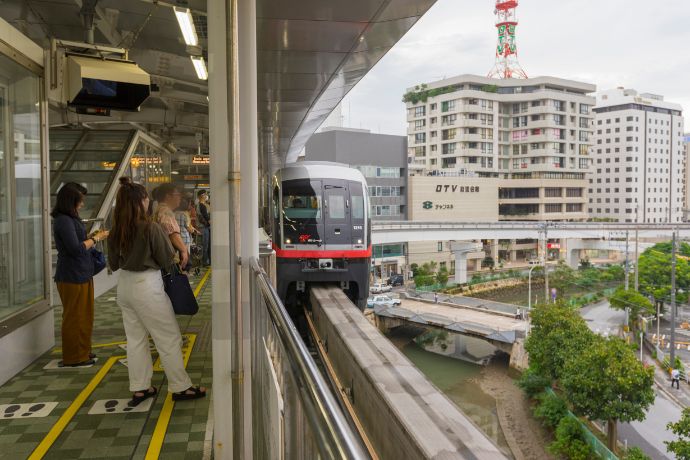
What’s Driving in Okinawa Like?
When driving in Okinawa, it is easy to forget you are driving in Japan. Yes, the cars drive to the left, the road signs are Japanese, and drivers tend to ignore speed limits to prioritise traffic rhythm. But the Okinawa driving style is more laid back.
Driving in Naha
Driving in Naha is like driving in any medium-sized Japanese city, but with better weather. Morning and evening rush hours can be busy, but Naha’s compact nature means that traffic jams don’t last for long. If heading to the airport to catch a flight, especially from the south and southeast, expect to navigate through Naha’s traffic.
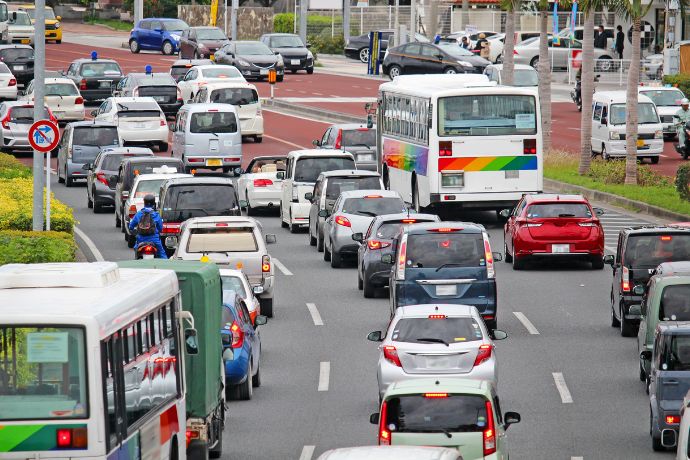
The newer parts of Naha can see substantial traffic jams. Conversely, older areas have narrow streets. Shuri Castle, atop a significant hill, is a particular driving challenge. Avoid driving to Shuri Castle directly if you can.

Driving outside Naha
Traffic lights are infrequent when you get out of Naha. Drivers in Okinawa stress less than in the rest of Japan when they approach yellow lights. Traffic makes you feel how laid-back Okinawa is.
Outside Naha, the roads fill up with” Kei” trucks used by the local fishermen, farmers, and businesses. Just like in the rest of Japan, they are the workhorses of the countryside.
Driving outside of Naha, especially in the Japanese countryside, is like driving on an almost empty road in a rural Japanese prefecture, with the roof down and ZZ Top at full volume.
Despite Okinawa’s compact size, travelling the island from end to end will take about 2.5 hours (with little traffic and good traffic conditions). But it’s a waste to rush it, as there is so much to see along the way. Skow down and take a few breaks, try the Okinawan cuisine, and look at the merchandise.
The Okinawa Expressway and National Roads
Okinawa has a single expressway, E58. It runs from Naha in the south to Nago (about in the middle of the island’s northern half). It covers about half of Okinawa Island’s length. The speed limit on the expressway is 80 kilometres per hour (47 mph),
If you are trying to drive to the northern part of Okinawa island from Naha, driving on the expressway makes it much faster than taking the local roads. However, making detours and seeing the scenery is more complicated on the expressway, as it was built to get quickly from one end of the island to the other, not for sightseeing.
This toll road costs 1020 yen from start to finish for ordinary cars. As with other Japanese expressways, your entry point is recorded, and you are charged when you exit.

An ETC card simplifies the payment process. You won’t pay for the ETC device if you’re renting a car. However, you pay for the road toll. You can preload ETC cards with a specific sum or pay when you return the rental car.
You’ll need to use national roads to visit attractions like Nakajin castle ruins or the Churaumi aquarium in northern Okinawa. These roads are accessible via interchanges located every 3-5 kilometres (2-3 miles) on the expressway. The national roads are almost as good as the E58 Expressway.
Different national roads run east and west of the E58 Expressway. They also continue beyond where the expressway ends. Together, they stretch from one end of the main island to the other end.
The national roads are often as good as the expressway, so be careful of speeding. The speed limit on national roads is between 40 and 60 kilometres per hour (25 to 37 mph). You may be overtaken by sports cars doing 120 kilometres per hour and more, but that’s way over the legal speed limit.
Road Quality in Okinawa
Okinawa’s road infrastructure is well-made and maintained. Several national roads are wide and open enough to connect the different parts of the island, and constant improvement projects make the roads even better.
The farming roads in Okinawa are well paved with hard shoulders. But they are often too narrow for anything other than two kei cars to meet.
Okinawa’s roads are made from local materials, including its unique star-shaped sand. However, this sand can be slippery when wet. To ensure safety, officials mix it with gravel from island limestone and use top-quality materials to prevent roads from deteriorating in the island’s heat and salty air.
Ferries in Okinawa
Ferries are used for longer-distance travel between islands – the ferry to the Daito islands takes 15 hours, and the ferry to Kagoshima takes 25 hours. However, flying is the most practical way of travelling between the major island groups like Okinawa Shoto, the Miyako Islands and the Yaeyama Islands.
Ferries are common for shorter journeys, like travel between the smaller islands in island groups, particularly Okinawa Shoto and the Yaeyama Islands. Causeways and bridges connect the Miyako islands, but ferry connections remain to more distant islands like Tarama Island.
You can easily book your ferry transfers through Klook.
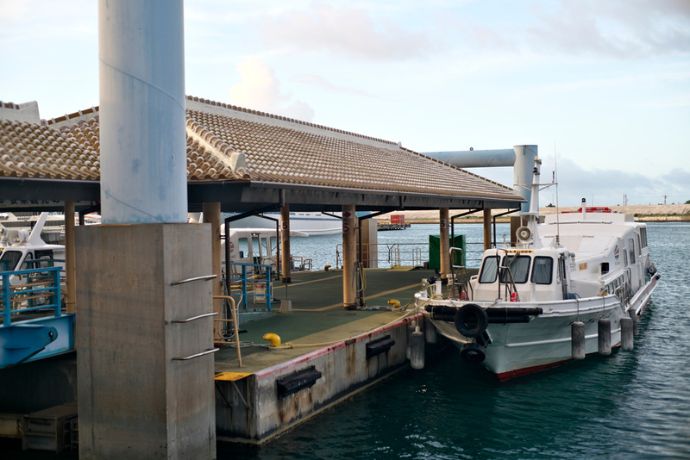
Going between Okinawa Island and the smaller islands around it usually takes 15 minutes and an hour. There are frequent services, mainly from Naha, but also many from other ports closer to the islands, such as Motobu and Nakajin.
You drive onto the ferry and leave your car on the car deck during the passage. Since the ferries tend to pack the vehicles closely together, make sure to park exactly in your allocated space. Engage the brake and put the gear in the parking position. Listen carefully for any announcements as you approach the destination – which may be Japanese only.
Night Driving and Weather Hazards in Okinawa
Driving at night on Okinawa Island – and even more so in the outlying islands – is harder than driving in the rest of Japan, mostly because of the total tropical darkness of Okinawa. The locals can also sometimes tend to push the speed limit.
Typhoon season (from about May to October) is daunting. Okinawa is situated in what is known as ‘typhoon alley’. The islands experience regular typhoons during the season.
The fierce storms disrupt transport with strong winds, heavy rain, and powerful waves. Typhoons discourage anyone from going out, let alone driving. They will cause ferries to cancel operations, roads to be closed due to the winds (that can push cars sideways), and police ask drivers to stay away from seaside roads due to the risk of being swept away by the waves.
The heavy rain that can precede and follow typhoons can also badly affect travel plans. You may be able to drive in the rain, but you won’t want to go sightseeing.
Michi no Eki in Okinawa
When driving around Okinawa, take the time to check out some Michi no Eki. ‘Michi no Eki’ (road stations) in mainland Japan usually balance local promotion and farmers’ markets. However, in Okinawa, they predominantly cater to tourists, emphasising regional specialties. These aren’t limited to local produce, such as fruits, vegetables, and seafood.
There are eight Michi no Eki, each with different foods to try and various Okinawa craft products. Two of the more interesting road stations are Michi No Eki Kadena and Michi No Eki Kyoda.
The Michi no Eki at Kadena is a popular sightseeing spot. It has an observation deck that overlooks the Kadena Air Base runway, so you can watch jet planes take off and land. A learning exhibition room features exhibits on Kadena’s history and the air base’s construction. Visitors can shop for souvenirs and enjoy specialities like the Jumbo Cheese Hamburger and Noguni Imo soft-serve ice cream.
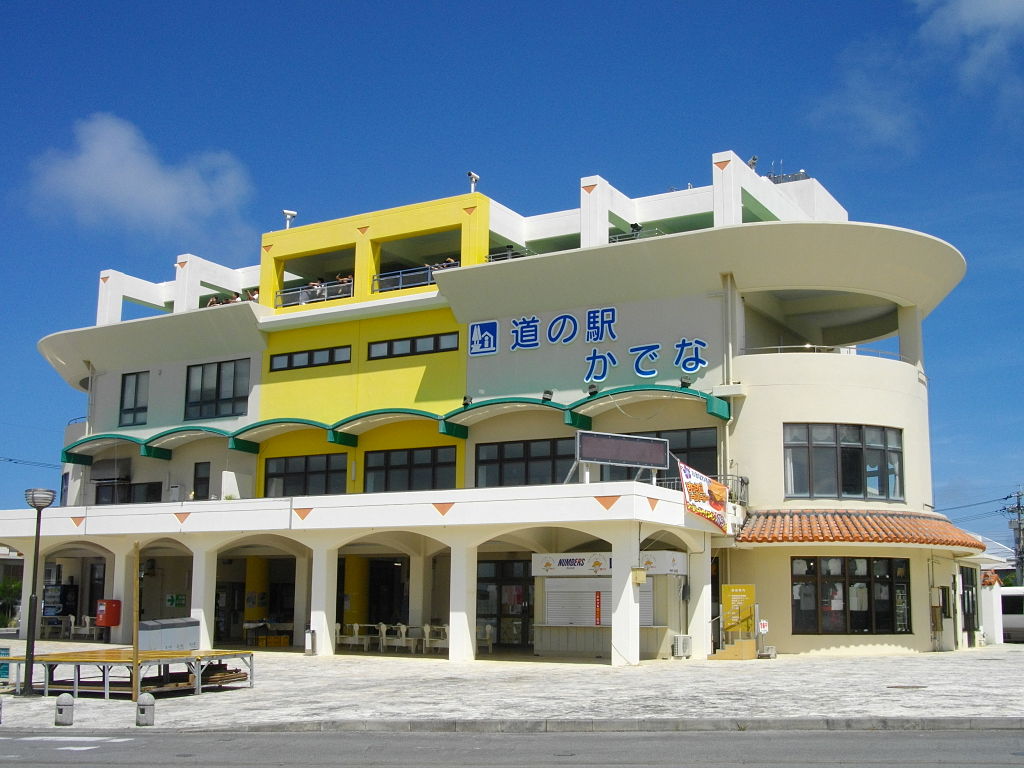
English: Abasaa日本語: あばさー, Public domain, via Wikimedia Commons
Michi no Eki Kyoda was the first Michi No Eki in Okinawa, opening in 1994. It showcases souvenirs like the Okinawan kariyushi shirts, similar to Hawaiian shirts. You can buy tropical fruits like mangos and pineapples, vegetables and flowers. There are also various food stalls and restaurants.
Renting a Car in Okinawa
Most travellers rent cars directly from the Okinawa airport car rental offices. However, there are other rental locations across south-central Okinawa, including locations that are convenient for those stationed at US bases.
We recommend that you use Klook to compare and book your car rental for Okinawa.
Renting in Okinawa follows the same process used in the rest of Japan. Essentials include:
- A national driver’s license.
- An International Driving Permit (IDP). If you have a driver’s licence from Switzerland, Germany, France, Belgium, Taiwan, or Monaco, you must get a Japanese translation of your licence instead.
- Passport (mandatory at all times in Japan).
- A credit card (MasterCard, Visa). Most rental companies will accept American Express. Debit cards aren’t accepted due to deposit requirements.
- Easy comparison of multiple car rental provider options using Klook, DiscoverCars or RentalCars
- TooCoo! is a local Japanese car comparison site that has the most options available
- Clear description of included protection and excess
- Good cancellation options
- Child seats, GPS, electronic toll cards, second driver and more are available as add-ons
In Okinawa, agencies often recognise the SOFA driver’s license (military personnel). Presenting this with a credit card typically suffices.
Choose a vehicle that suits your needs, considering the number of people and luggage volume. A regular sedan or compact SUV should be fine for families of four (particularly if you have younger kids). If you have bulky luggage or a larger group, consider a seven-seater like the Nissan Serena, Toyota Voxy or Honda Stepwgn.
It’s important to book early. Book at least three months ahead to secure your preferred type of car. During peak periods, you may need to book even further in advance. Popular and less common cars run out quickly.
Driving Rules in Okinawa
Historically, Okinawans drove on the left. However, post-WWII US occupation led to right-side driving. Okinawa returned to left-side driving in 1978, following Okinawa’s return to Japan in 1972.
Today, Okinawa follows the same road rules used in other parts of Japan. Key points include:
- Drive on the left side.
- Overtake from the right.
- There is a strict blood alcohol content level of 0.03.
- Don’t use cell/mobile phones unless a passenger is using it.
- Seat belts are mandatory for all passengers.
- Children up to age 6 need child seats.
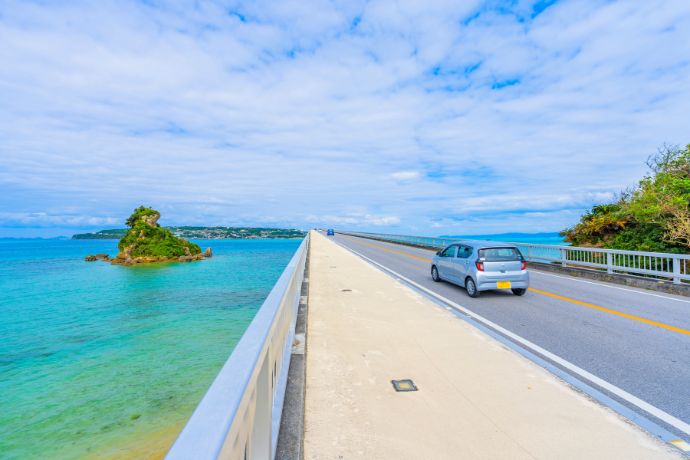
A unique aspect of driving in Okinawa is the presence of US military transports, including heavy equipment. Always be aware of them. While they strive to minimise interference with civilian traffic, drivers must be cautious.
Road Signs and Traffic Lights in Okinawa
As in mainland Japan, the most important signs include the stop sign, speed limits, and the no-overtaking sign, especially prevalent on narrower roads. I’ve written a more detailed article on Japanese road signs.
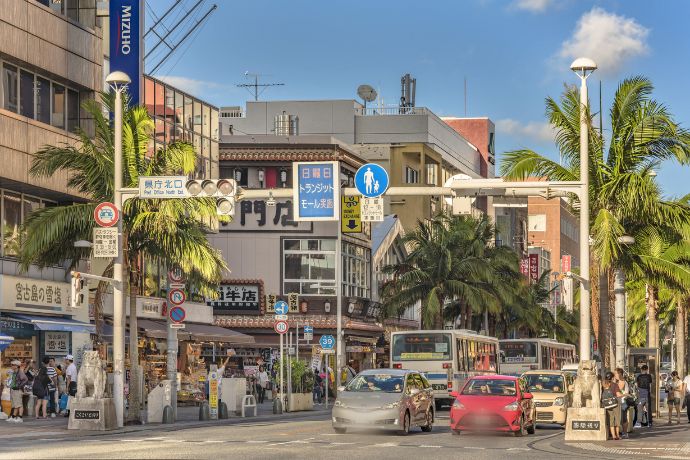
Okinawa has the same speed limit signs as the rest of Japan. Be especially cautious near schools. The strict 30 km/h limit applies, even if not prominently marked, and exceeding this can result in fines.
Okinawa’s traffic lights follow the typical traffic light sequence. Try to stop when the light is yellow since running a red light carries stiff penalties. Check out my Japanese traffic lights article for more information.
Parking in Okinawa
Pay attention to ‘no stopping’ and ‘no parking signs’. In Okinawa, it’s common to see cars parked on small farm roads regardless of signs, especially in rural areas, but be cautious of such stops. Parking violations can cost between 10,000 and 18,000 yen, depending on the infringement.
Naha’s narrow, steep streets can make parking tricky, unless you use a paid parking garage.
In contrast, most stores and attractions outside of Naha offer ample parking since Okinawa is car-centric.
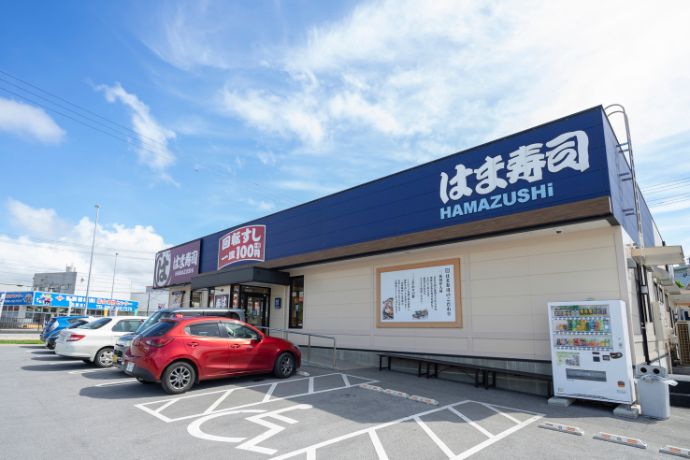
Tourist spots like beaches and dive sites may have parking fees ranging from 200 to 500 yen per day. Parking fees are usually paid to a parking lot attendant, either stationed at the parking entrance or guiding drivers.
However, businesses with an entry fee often include parking in the ticket price. Shopping centres and stores also generally offer free parking, allowing short-term use even if you’re visiting nearby beaches.
Check out my Car Parking in Japan article for more information.
Gas Stations in Okinawa
Keep an eye on your fuel levels in Okinawa so you don’t run out of gas, especially in the less populated northern third of Okinawa Island. Use the roadside phones if you’re on the expressway and need help. Remember, operators may not speak English.
Most major rental car companies provide English-speaking emergency call centres in Okinawa. Your base should provide an emergency number for US military members. Otherwise, call 110 for the police, but this might require some Japanese proficiency.
Gas stations, known as “gasoline stands”, are commonly near major road junctions and around small cities. In the northeast, the village of Aha houses the only gas station.
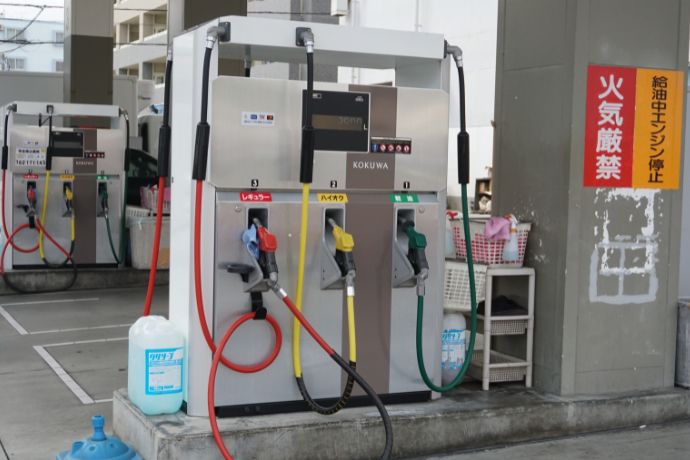
Common brands include Eneos, Cosmo, Apollo, Mitsubishi Energy, and JA (Japan Agriculture).
There are occasional full-service gas stations, but they have become scarce in Okinawa, just like the rest of Japan. Most gas stations are self-service, with payment machines that usually accept credit cards. Eneos and Cosmo stations often have English payment menus, while Apollo, Mitsubishi, and JA stations may not.
When renting a car, pay attention to the type of fuel required. Gasoline types are colour-coded: green for diesel, red for premium, and yellow for regular. Ensure you’re using the appropriate fuel for your vehicle. Gas prices in Okinawa are similar to the rest of Japan.
Some stations offer amenities like free air or cleaning tools. It’s courteous to return items after use and tidy up in self-service areas.
Check out my Japanese Gas Stations article for more information.
Scenic Routes and Driving Itineraries in Okinawa
Okinawa has a considerable number of scenic drives. Below are five examples of drives you can take that will be a memorable experience.
Okinawa Western Coast Exploration Route
Chatan – Zanpa Lighthouse – Onna – Nago. Return via the expressway.
This west coast route will take you past some of the most famous sights in Okinawa, including the Blue Cave, the Elephants Trunk on Cape Manzamo, and Ryukyu Mura and Nago Pineapple Park.
The drive itself takes less than three hours without stopping, excluding return, so plan to make a full day of it. And one more thing – this route is spectacular at sunset.
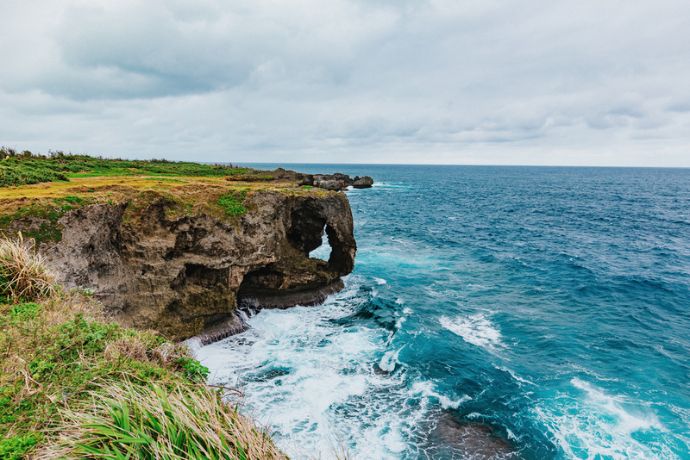
Okinawa Eastern Coast Exploration Route
Nishihara Kira Kira Beach – Nakagusuku Castle Ruins – Hamahiga Island – Ikei Island – Tengan Pier – Cave Okinawa – Return on the expressway.
This route takes you across three bridges to islands with spectacular views and beautiful beaches, but also past the Nakagusuku castle ruins, majestically reconstructed as a reminder of when warring tribes occupied Okinawa. It ends in Cave Okinawa, one of the many caves on the island, which is spectacularly lit.
The route takes about three hours to drive without stopping, so plan to make a full day of it!
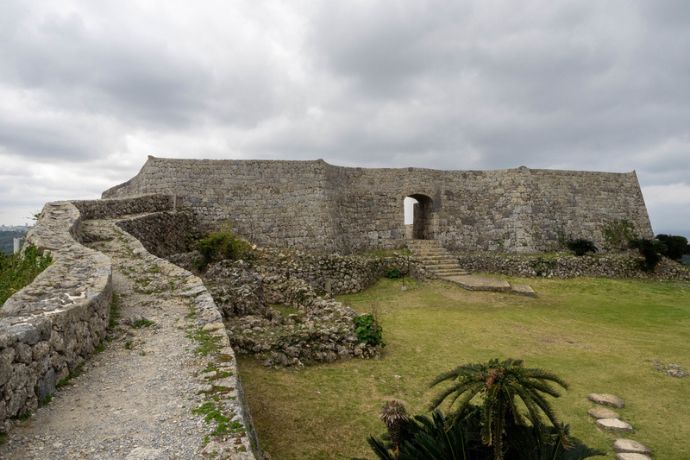
Okinawa Central Exploration Route
Kyoda Interchange (IC) – Todoroki Waterfall – Nago Pineapple Park – Nakijin Castle Ruins – Yagaji Island – Matakina Bridge – Oura Mangrove Park – Futami Melody Road – Sea Glass Beach – Ginoza IC
This route takes you from one end of the Okinawa expressway to the Todoroki Waterfall (easily accessible), Nago Pineapple Park (must-see tourist trap), and the Nakijin Castle Ruins. Only the ramparts remain since the castle was destroyed in the Japanese invasion in the 17th century.
You then cross the bridges of Yagaji and Ojima islands, continuing by the Matakina bridge over the Haneji reservoir, past Okinawa mangroves, and onto a melody road (which plays a song as you drive over it). After that, you pass the Sea Glass Beach and take the Okinawa Expressway back to Naha.
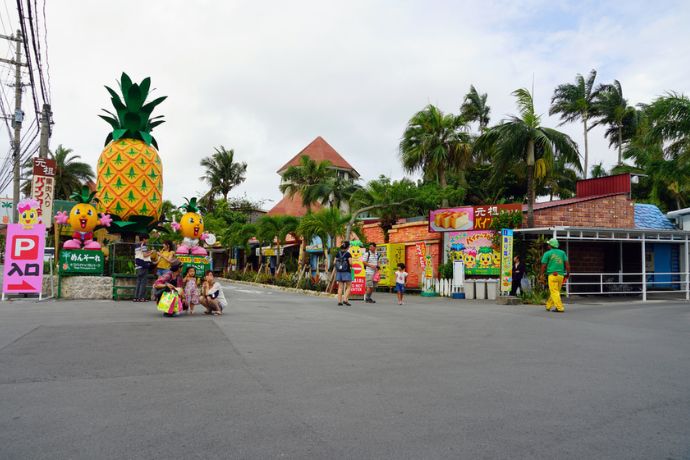
Okinawa Northern Coast Exploration Route
Ogimi roadside station – Cape Hedo – Oku Port – Ie beach – Sosu beach – Yanbaru Kuina Ecological Exhibition – Fukuji Dam Upstream Flood Discharge – Ogimi Village Observation Deck – Ogimi Roadside Station
This route takes you from the village of Ogimi along the coast to Cape Hedo, the northernmost point on Okinawa Island. You then travel south along the eastern coast through the Yanbaru National Park to the mouth of the Fukuji River and back across the island to the Ogimi Village Observation Deck with spectacular views. It takes about 3 hours of driving time, without stopping, so plan to take a full day to explore this route.
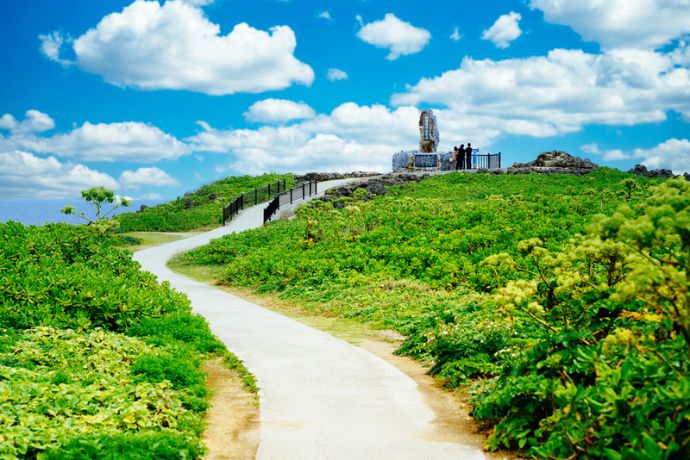
Okinawa Southern Coast Exploration Route
DMM Karayushi Aquarium – Todoroki Cavern – Gushikawa Castle – Cape Kyan – Yamagusuki Uriguchi – John Manjiro Landing – Okinawa Prefectural Peace Memorial Museum – Sefa-Utaki – Okinawa World – back to DMM Karayushi Aquarium.
The DMM Karayushi Aquarium is a small but interesting aquarium outside Okinawa. The Todoroki Cavern is a small cavern with a tragic history from WWII. It has no supporting framework (you can enter; bring a pocket torch).
Gushikawa Castle ruins are less well-kept than others, but it has nice views. Cape Kyan is the southernmost peak in Okinawa. Yamagusuki Uriguchi is a beach with interesting rock formations.
John Manjiro Landing is where John Manjiro, a samurai who learned English and played a crucial role during the Meiji Restoration, landed in Japan.
The Okinawa Peace Memorial Museum is a sobering reminder of the violent history of Okinawa. Sefa-Utaki is sacred in the native Okinawan religion. Okinawa World is an Okinawa cultural experience park and impressive cave.
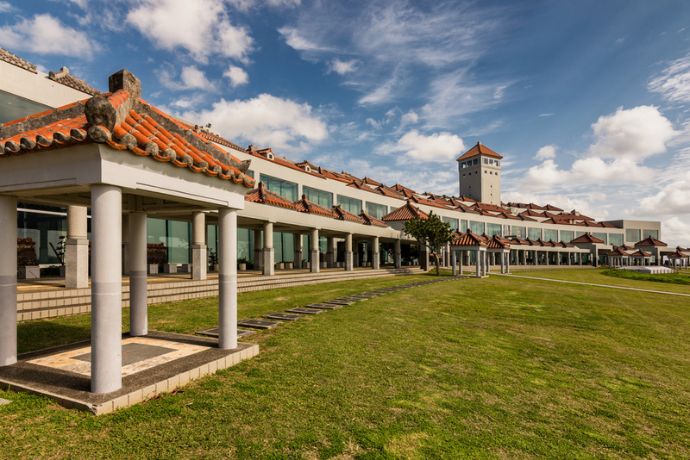
The entire drive takes about 3 – 3.5 hours without stops. If you make all the stops, this can be a two-day experience.
Additional Tips and Advice
If you rent a car in Okinawa, you might notice a sticker telling others that the driver is a foreigner. The sticker is a caution for others to be patient, given your unfamiliarity with Japanese driving norms.
Japanese drivers are notably more attentive to each other than drivers in other countries. They often use brake lights and direction signals as communication tools. It’s common to flash hazard lights as a thank-you gesture when given road courtesy.
Okinawans, used to the military presence and international tourists, are relatively tolerant of non-Japanese drivers.
If you’re from a country where driving is on the right, stay focused, especially if jetlagged, to avoid instinctively changing back to your regular driving habits.
In the event of an accident, contact the emergency numbers from your rental agency or military base. Consider letting the other person involved in the accident notify the police, as they will probably be more proficient in speaking Japanese.
- Easy comparison of multiple car rental provider options using Klook, DiscoverCars or RentalCars
- TooCoo! is a local Japanese car comparison site that has the most options available
- Clear description of included protection and excess
- Good cancellation options
- Child seats, GPS, electronic toll cards, second driver and more are available as add-ons
Frequently Asked Questions About Driving in Okinawa
Suppose you want to go to the beaches, surf, or see the unique Okinawan culture or nature. In that case, you will need a car in Okinawa. There is limited public transport, and Okinawa is a car-oriented society.
Following are some frequently asked questions about driving in Okinawa.
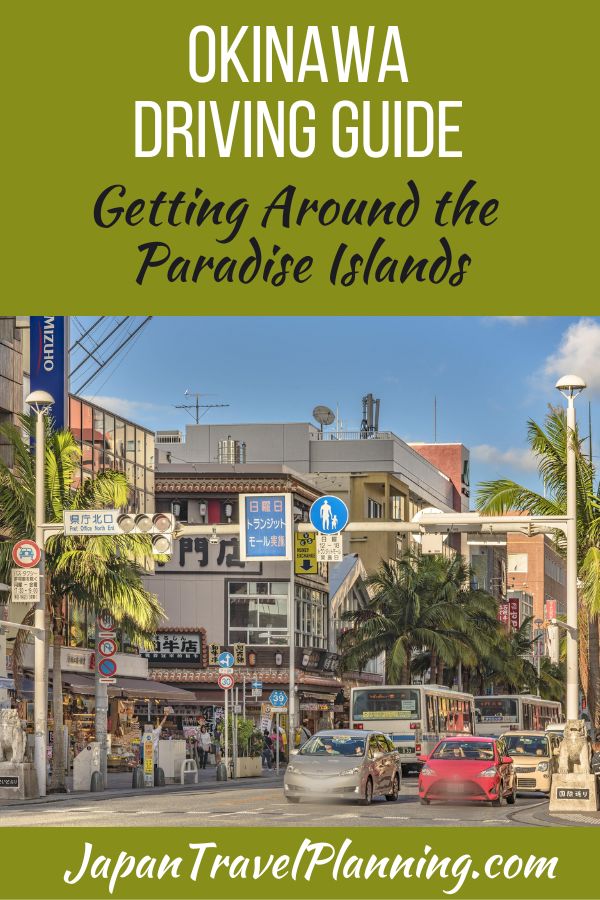
Join the Japan Travel Planning Facebook Group or Discord Server
You are also welcome to join our Japan Travel Planning Facebook Group and our Japan Travel Planning Discord Server – they are great resources to enable you to ask questions about your upcoming trip to Japan!
Disclaimer: This article contains affiliate links. If you book after clicking on one of these links then we may receive a small commission at no extra cost to you.

